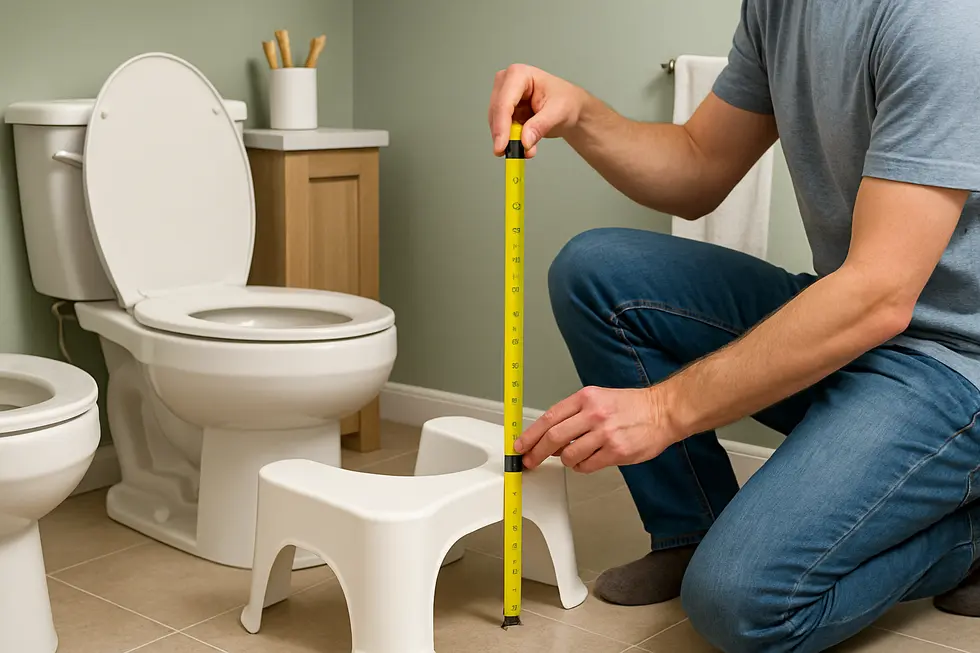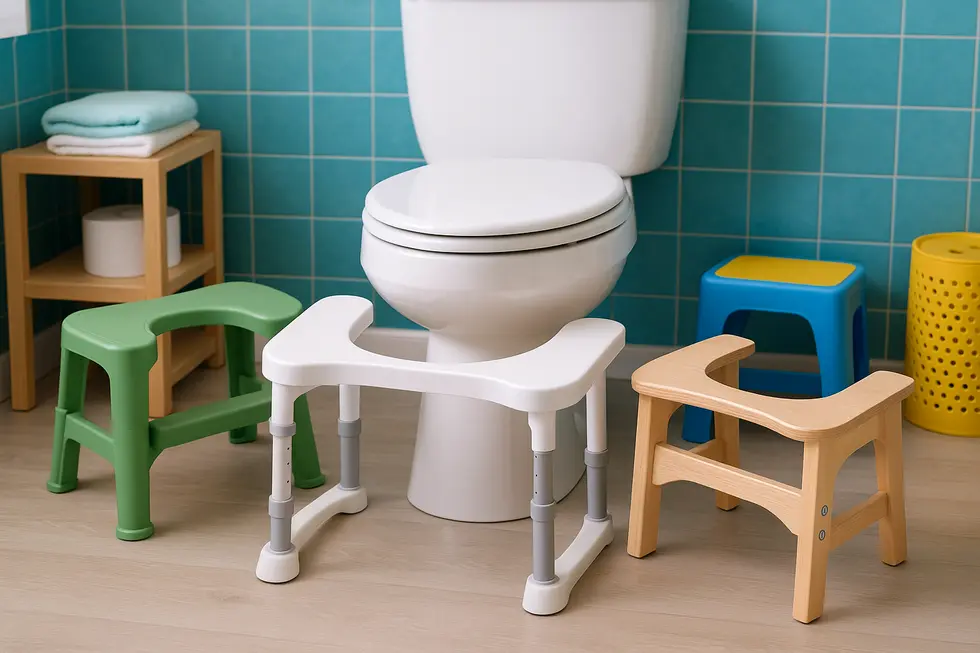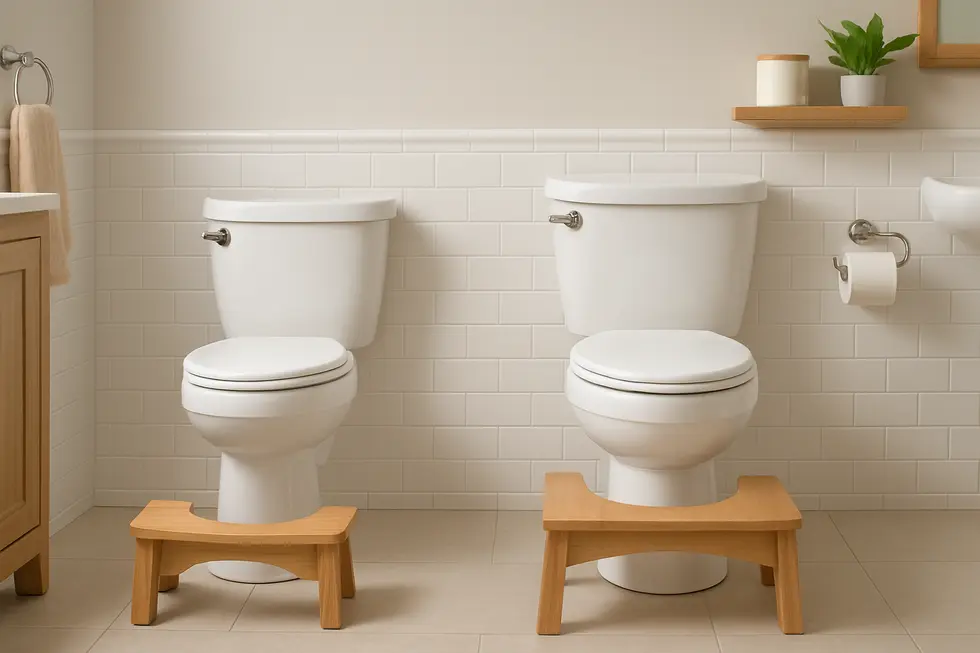Toilet Stools
Optimal Toilet Stool Heights: A Family Guide to Comfort and Health
Finding the perfect height for your toilet stool can transform your bathroom experience, improving posture and aiding digestive health. Families often have varying needs, making it important to choose the right stool height for different household members. This guide explores ergonomic considerations, adjustable options, and the health benefits of selecting the ideal toilet stool height, providing a comprehensive roadmap for family well-being.
Aligning Seat and Feet: Ergonomic Math for Choosing the Ideal Toilet Stool Height

Finding the sweet spot for a toilet stool begins with a simple equation: seat height + stool height = a posture that lets your knees rise above your hips by roughly 35°. That angle relaxes the puborectalis muscle, straightening the rectum so waste exits with less strain. Miss the mark—even by an inch—and the promised “natural squat” feels awkward or, worse, aggravates joints and circulation.
Most residential bowls place the seat 16–18 inches from the floor. Accessible models stretch to 20 inches so users with limited mobility don’t need to crouch deeply. Measure yours from the finished floor to the center of the seat’s front edge. If the tape reads 16 inches, a classic 7-inch footstool will usually lift the knees into the target zone. Tip the tape to 18 inches? You will likely need a 9-inch riser, or an adjustable design that flips between settings. Remember: raising the stool is easier than lowering the toilet.
Ergonomics also cares about what happens inside the body. Elevating the feet reduces the pressure gradient between abdominal and rectal cavities, cutting the average strain time by up to 50 percent in clinical scans. Users with hemorrhoids report less swelling; people managing constipation note faster, more complete evacuation. Conversely, if the stool is too low, they instinctively push harder; too high, and hip flexion becomes excessive, pinching nerves behind the thigh.
Households with children or elders must juggle different limb lengths. A nested, two-stage stool lets kids perch on the higher tier while adults flip it to the lower side. For seniors, look for broad, non-slip platforms that allow a shoulder-width stance; narrow steps concentrate pressure on arthritic ankles.
If you’re unsure, start modestly. Place a stack of hardcover books under each foot until the posture feels right, then measure the stack’s height as your custom benchmark. Only after confirming comfort should you invest in a purpose-built aid—the materials and anti-bacterial coatings will pay durability and hygiene dividends over time. For a deeper dive into tailoring dimensions to body type, the perfect toilet stool height guide breaks down real-world user cases.
Ergonomic success ultimately means you hardly notice the stool at all; it simply disappears beneath relaxed muscles and effortless routines.
Fine-Tuning Stool Height: Adjustable Platforms and Home Factors That Perfect the Toilet Squat

Finding the sweet spot between your toilet’s height and your feet’s elevation is a small adjustment that pays off every day. Healthcare research shows that a seat rising somewhere between 14 and 19 inches allows most people to sit without hip strain, while still standing up easily. Yet your work is only half done once the bowl is chosen; the elevation beneath your feet must now match the seat so your knees lift above your hips and the rectum straightens.
Because households rarely share the same anatomy—or the same toilet—flexible footstools have become the quiet hero of bathroom ergonomics. A dual-height model that flips from roughly 7 to 9 inches solves the common mismatch between standard bowls (14–16 in.) and comfort-height bowls (16.5–18 in.). Children grow, guests vary, and sometimes a recovering knee demands extra leverage; a platform that can switch heights without tools accommodates all these shifts in real time.
Space is the next variable. Before ordering, measure the clearance in front of the bowl as well as the distance to the vanity door. Many adjustable designs nest around the toilet base when not in use, preventing trip hazards in tight powder rooms. Material choice matters, too. Lightweight plastic moves easily for cleaning but can slide on glossy tile; wood offers grip and warmth, yet takes a little more effort to lift. Whichever surface you choose, look for gentle contours that cradle the arches so your heels don’t dangle and ankles stay relaxed.
Households with seniors or anyone managing joint pain may even pair a taller seat with the same stool by adding screw-on risers supplied by some manufacturers—an economical way to avoid buying multiple platforms. For families curious about design options, this primer on adjustable toilet stools explores ergonomics, materials, and cost.
When stool and seat act in harmony, the body settles into a natural squat, abdominal muscles engage, and bowel emptying often feels quicker and more complete. The right combination turns a routine necessity into a moment of comfort (see the full seat-height reference chart here: https://hawthornephc.com).
From Joint Relief to Colonic Ease: How the Perfect Toilet Stool Height Protects Joints and Powers Digestion

Selecting the ideal height for a toilet stool is more than a comfort tweak; it is a small architectural choice that echoes through the body. When the seat rises to 17–19 inches and the feet rest on a 7- or 9-inch platform, the knees approach hip level without forcing a deep bend. This seemingly modest adjustment shortens the distance you need to descend, easing pressure on arthritic knees, aching hips, and a stiff lower back. Researchers studying chair-height toilets confirm that reducing the sit-to-stand angle can lower joint loads and lower the risk of falls, making bathroom visits safer for seniors and post-surgery patients (source).
Yet mobility is only half the story. Elevating the feet also changes the internal landscape of the pelvis. In a conventional sitting position the anorectal angle tightens, creating a kink that demands straining. A footstool relaxes this angle, allowing the rectum to straighten so waste can exit with minimal effort. Users often report faster, more complete evacuation, fewer episodes of constipation, and less reliance on laxatives. Clinicians note that reduced straining lowers the likelihood of hemorrhoids, fissures, and pelvic-floor weakening—issues that can silently erode quality of life.
The synergy between an elevated seat and a properly sized stool becomes especially valuable in multi-user homes. A taller adult may pair a comfort-height toilet with a 9-inch stool, while a child can flip an adjustable model to 7 inches on a standard bowl. This adaptable setup keeps everyone’s joints safe and their bowels moving efficiently without crowding the bathroom with multiple accessories. For families caring for older relatives, resources like the guide on toilet stools for elderly safety and comfort illustrate how a single, height-tunable platform can replace cumbersome grab bars or powered lifts in many situations.
Ultimately, the correct stool height harmonizes musculoskeletal ease with digestive performance. By respecting both the outer mechanics of sitting and the inner mechanics of elimination, a well-chosen elevation quietly turns every bathroom break into an act of self-care.
Final thoughts
Selecting the right toilet stool height can profoundly impact family comfort and health. By adhering to ergonomic guidelines, considering adjustable solutions, and understanding the health benefits, families can enhance their bathroom experience. Prioritizing these aspects fosters a healthier lifestyle, ensuring everyone enjoys both comfort and effective digestive health.
Experience a new standard of clean with PEGABidet—designed for comfort, safety, and independence. Join thousands who trust us to make personal care simple and dignified. Contact us contact@pegabidet.com
About us
PEGABidet is a brand owned by L.A NEXTGEN LLC, based in California. We design intuitive, hygienic, and accessible bathroom solutions that prioritize safety, dignity, and independence. Our mission is to make personal care effortless and empowering for people at every stage of life.

